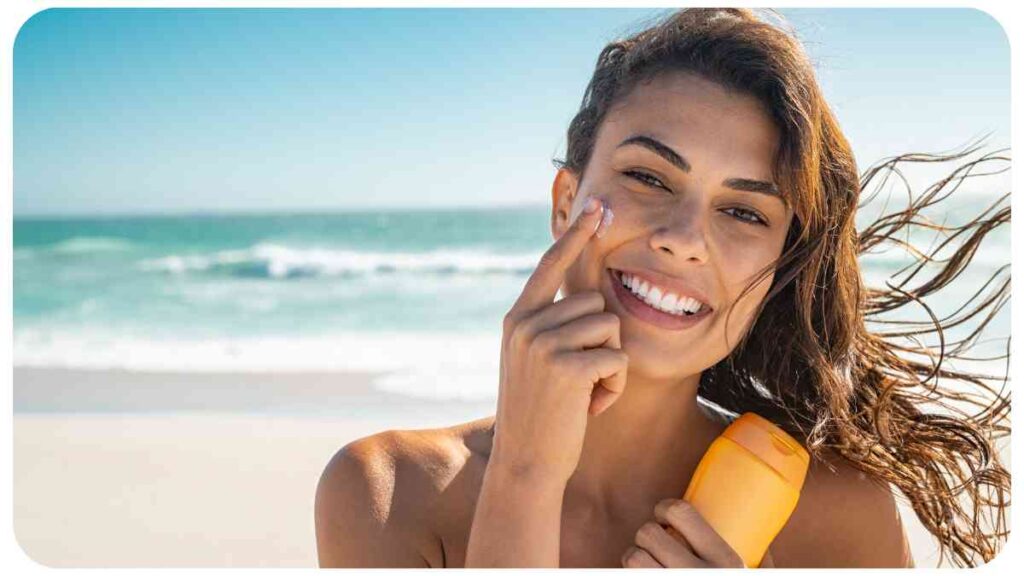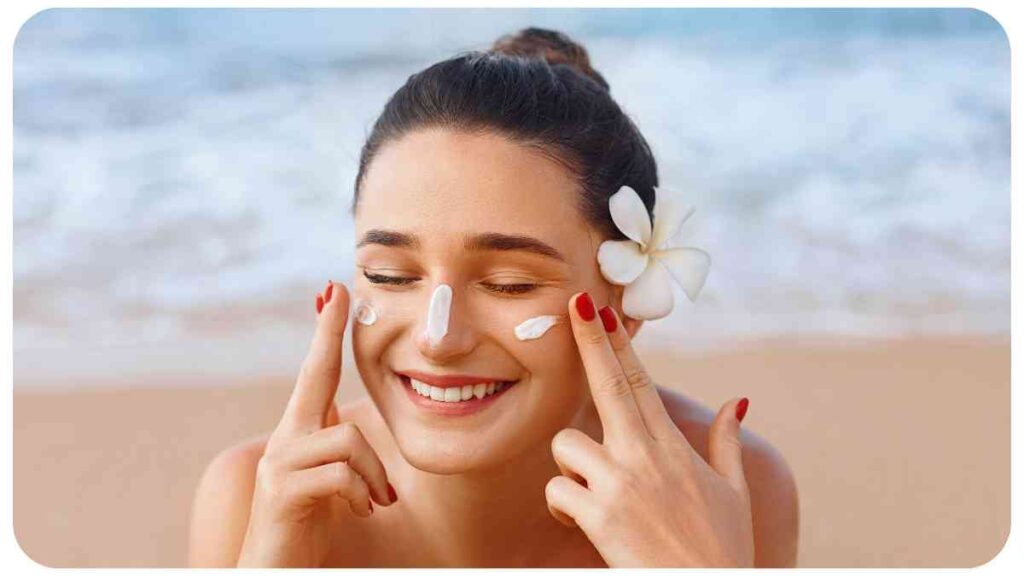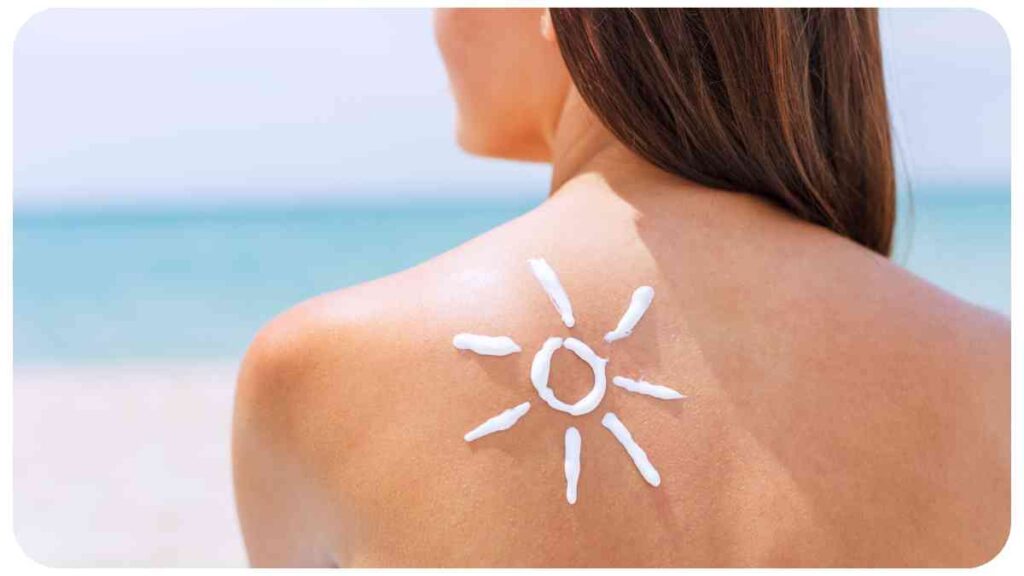Welcome to our comprehensive guide on how to properly apply sunscreen. In this article, we will explore the importance of sunscreen, debunk common misconceptions, provide tips for choosing the right sunscreen for your skin type, and offer expert recommendations for effective application.
We’ll also discuss how to combine sunscreen with makeup, explore different sunscreen recommendations for outdoor activities, address sunscreen needs for specific age groups and skin conditions, highlight common sunscreen mistakes to avoid, and much more.
| Key Takeaways |
| Proper application of sunscreen is essential for effective sun protection. |
| Using an adequate amount of sunscreen and applying it to all exposed areas is crucial. |
| Reapplying sunscreen regularly, especially after sweating or swimming, helps maintain protection. |
| Considering environmental impact, such as opting for reef-safe and eco-friendly sunscreens, is important. |
| Understanding the risks and consequences of sunburn can help motivate proactive prevention. |
| Taking additional sun protection measures like seeking shade, wearing protective clothing, and staying hydrated is recommended. |
| Educating oneself on sunscreen usage through reputable sources can enhance sun protection awareness. |
2. The Importance of Sunscreen
Protecting your skin from harmful ultraviolet (UV) rays is essential for maintaining optimal skin health. Sunscreen acts as a protective barrier that shields your skin from these harmful rays, preventing sunburns, premature aging, and reducing the risk of skin cancer. By incorporating sunscreen into your daily routine, you can enjoy the outdoors while safeguarding your skin.
When it comes to sustainable fashion, The Ultimate Guide to Sustainable Fashion Brands provides an extensive list of eco-friendly options, making it easier to align your beauty and fashion choices with your values.
Table: Benefits of Sunscreen
| Benefit | Description |
| Protection from UV | Shields the skin from harmful ultraviolet (UV) rays, preventing sunburns, premature aging, and more. |
| Reduces Skin Cancer Risk | Minimizes the risk of skin cancer by blocking harmful UVA and UVB rays. |
| Prevents Photoaging | Slows down the aging process caused by sun damage, reducing fine lines and wrinkles. |
3. Understanding Sun Protection Factor (SPF)

Sun Protection Factor, widely known as SPF, is a crucial element to consider while purchasing sunscreen. It indicates the level of protection a sunscreen provides against UVB rays, which are responsible for sunburns. SPF values range from 15 to 100, with higher numbers indicating greater protection.
However, it’s important to remember that no sunscreen offers 100% protection, and reapplication is necessary to maintain effectiveness.
Table: SPF Levels and their Corresponding Protection
| SPF Level | Level of Protection |
| SPF 15 | Blocks 93% of UVB rays |
| SPF 30 | Blocks 97% of UVB rays |
| SPF 50 | Blocks 98% of UVB rays |
| SPF 100 | Blocks 99% of UVB rays |
4. Common Misconceptions about Sunscreen
It’s important to address some common misconceptions about sunscreen to ensure that you have a clear understanding of its role in protecting your skin.
Discover the countless benefits of incorporating organic beauty products into your routine with The Benefits of Using Organic Beauty Products. Embrace the power of nature for healthier, glowing skin and a more sustainable beauty regimen.
Table: Addressing Common Misconceptions
| Misconception | Explanation |
| Sunscreen is only needed on sunny days | UV rays can penetrate through clouds and cause damage to the skin. Therefore, sunscreen should be applied regardless of the weather. |
| Darker skin doesn’t need sunscreen | While it’s true that darker skin tones have more natural protection against UV rays, sunscreen is still essential for maintaining skin health. |
| Sunscreen is not necessary indoors | Although UVB radiation is blocked by windows, UVA radiation can still penetrate through glass, making sunscreen important even indoors. |
| A higher SPF means all-day protection | No sunscreen provides all-day protection. Reapplication every two hours, or more frequently if sweating or swimming, is essential. |
5. Choosing the Right Sunscreen for Your Skin Type
Finding the appropriate sunscreen for your skin type is crucial for ensuring comfortable and effective sun protection. Consider the following table that outlines sunscreen recommendations based on different skin types.
Table: Recommended Sunscreens for Different Skin Types
| Skin Type | Recommended Sunscreen |
| Normal | Broad-spectrum sunscreen with SPF 30 or higher |
| Dry Skin | Moisturizing sunscreen with added hydrating ingredients |
| Oily Skin | Oil-free or gel-based sunscreen |
| Combination | Lightweight sunscreen with oil-absorbing properties |
| Sensitive | Fragrance-free, hypoallergenic sunscreen |
| Acne-Prone | Non-comedogenic (won’t clog pores) sunscreen |
| Aging Skin | Sunscreen with anti-aging benefits, such as antioxidants |
Now that you have a better understanding of sunscreen and how to choose the right one for your skin type, let’s dive deeper into the proper application techniques.
6. How to Apply Sunscreen Properly

To ensure maximum effectiveness, it’s crucial to apply sunscreen properly. Follow these steps for proper application:
Step 1: Preparing Your Skin
Before applying sunscreen, cleanse your face and body using a gentle cleanser. Ensure your skin is dry before proceeding to the next step.
Step 2: Determining the Right Amount of Sunscreen
It’s important to use an adequate amount of sunscreen to ensure proper coverage. As a general guideline, aim for approximately one ounce (about a shot glass full) to cover your entire body. For your face, use about a pea-sized amount.
Shield your skin from sun damage by following The Skincare Routine You Need for Fighting Sun Damage. Learn how to protect, repair, and maintain a healthy complexion even under the sun’s harmful rays.
Step 3: Applying Sunscreen to Different Body Parts
Table: Tips for Applying Sunscreen to Different Body Parts
| Body Part | Application Tips |
| Face | Apply sunscreen to your forehead, cheeks, nose, and chin, spreading it evenly. |
| Neck | Extend the application to your neck, making sure to cover the entire area. |
| Arms and Legs | Apply sunscreen to each arm and leg separately, focusing on areas exposed to the sun. |
| Back | If possible, ask someone for help to ensure proper sunscreen application on your back. |
| Ears | Don’t forget to protect your ears by applying sunscreen to the front and back of each ear. |
Step 4: Reapplying Sunscreen Throughout the Day
Remember that sunscreen wears off over time, especially with activities that involve sweating or swimming. Reapply sunscreen every two hours or more frequently if needed.
Step 5: Additional Tips for Effective Sunscreen Application
Table: Additional Tips for Proper Sunscreen Application
| Tip | Description |
| Apply sunscreen 15-30 minutes before sun exposure | This allows time for the sunscreen to fully absorb into the skin, maximizing its effectiveness. |
| Use broad-spectrum sunscreen | Broad-spectrum sunscreen protects against both UVA and UVB rays. |
| Don’t forget about your lips and other exposed areas | Apply a lip balm with SPF to protect your lips and consider using a hat, sunglasses, and clothing to cover other areas. |
| Apply sunscreen on cloudy days | Even though clouds block some UV rays, a significant amount can still reach your skin. |
| Check the expiration date | Expired sunscreen may not provide the desired level of protection. |
By following these steps and tips, you can ensure proper sunscreen application and take proactive steps to protect your skin from the sun’s harmful rays. Remember to always make sunscreen a part of your daily skincare routine for optimal results.
Uncover hidden secrets and reveal your true fragrance personality by exploring 10 Secrets to Choosing the Perfect Fragrance for Your Personality. Find your signature scent that captivates and expresses your unique individuality.
7. Sunscreen and Makeup: How to Combine Them Effectively
Many individuals like to wear makeup on a daily basis, and it’s essential to learn how to properly combine sunscreen and makeup for effective sun protection without compromising the appearance of your makeup. Here are some tips to help you achieve that balance:
Finding Sunscreen-Friendly Makeup Products
Not all makeup products work well with sunscreen, so it’s important to choose products that won’t interfere with the effectiveness of your sun protection. Look for makeup products that are labeled “sunscreen-friendly” or “oil-free,” as these are less likely to disrupt or dilute the sunscreen.
Table: Sunscreen-Friendly Makeup Products
| Makeup Product | Characteristics |
| Foundation | Lightweight, oil-free, and labeled as non-comedogenic (won’t clog pores) |
| BB/CC Cream | Combination of skincare, sunscreen, and light coverage; choose SPF-infused |
| Powder | Mineral-based powder with SPF, suitable for touch-ups throughout the day |
| Lip Balm | Lip balm or lipstick with SPF for sun protection and moisturization |
| Setting Spray | Setting spray with SPF to lock in makeup and provide additional sun protection |
Tips for Applying Sunscreen and Makeup Simultaneously
Table: Tips for Combining Sunscreen and Makeup
| Tip | Description |
| Apply sunscreen as the first step in your skincare routine | Allow the sunscreen to fully absorb into your skin before applying makeup. |
| Use a lightweight sunscreen suitable for the face | Choose a non-greasy sunscreen that won’t interfere with the texture or longevity of your foundation or other makeup products. |
| Wait a few minutes after applying sunscreen | Once you’ve applied sunscreen, give it a few minutes to set before proceeding with your makeup application. |
| Opt for a primer with SPF | Consider using a primer with SPF to create a smooth canvas for your makeup while providing an extra boost of sun protection. |
| Blend foundation or BB/CC cream with sunscreen | Mix a small amount of sunscreen with your foundation or BB/CC cream for a seamless application that combines coverage and sun protection. |
| Don’t forget to reapply sunscreen throughout the day | If you need to touch up your makeup during the day, opt for a powder with SPF or use a setting spray that provides additional sun protection. |
By following these tips and choosing suitable products, you can effortlessly incorporate sunscreen into your makeup routine and achieve both sun protection and a polished, flawless look.
8. Sunscreen for Different Outdoor Activities
When engaging in various outdoor activities, it’s important to consider the specific sun protection needs for each activity. Here are some recommendations for different outdoor activities:
For those with oily skin, The Best Makeup Products for Oily Skin are essential to achieving a flawless, shine-free complexion. Discover the holy grail products that keep your skin looking fresh and mattified all day long
Beach and Pool
- Choose a water-resistant sunscreen with a high SPF to protect your skin while swimming or lounging by the water.
- Reapply sunscreen every two hours, or more frequently if you’re sweating or towel-drying yourself.
Hiking and Camping
- Opt for a sunscreen lotion or stick that is easy to apply and portable.
- Pay extra attention to areas that may be exposed to intense sunlight, such as the face, neck, ears, and back of the hands.
- Consider wearing a hat, sunglasses, and protective clothing, in addition to sunscreen, for further sun protection.
Sports and Exercise
- Use a sweat-resistant sunscreen that won’t run into your eyes during physical activities.
- Apply sunscreen to all exposed areas, including the scalp if you have thin or no hair, and consider wearing a sweat-wicking hat or headband.
- Reapply sunscreen as needed, especially after excessive sweating.
Everyday Outdoor Activities
- Apply a broad-spectrum sunscreen with an appropriate SPF value for your everyday activities.
- Don’t forget to protect areas that are often overlooked, such as the tops of the feet, ears, and back of the neck.
- If possible, seek shade during peak sun hours (usually between 10 am and 4 pm) to reduce overall sun exposure.
By tailoring your sunscreen application based on the specific outdoor activity, you can enjoy your time outside while minimizing the risk of sun damage.
9. Sunscreen for Different Ages and Skin Conditions

Sunscreen needs can vary based on age and specific skin conditions. Here are some recommendations for different age groups and skin conditions:
Sunscreen for Babies and Children
- Use a sunscreen specifically formulated for babies and children with a minimum SPF of 30.
- Choose a sunscreen that is free from fragrances and harsh chemicals to minimize the risk of irritation.
- Apply sunscreen generously and frequently, and consider using physical sun protective measures such as hats and shade.
Sunscreen for Seniors
- Select a broad-spectrum sunscreen with a higher SPF to provide ample protection for mature skin.
- Look for formulas containing moisturizing ingredients to address dryness common in aging skin.
- Apply sunscreen on all exposed areas, including the hands and arms, as they may receive increased sun exposure.
Sunscreen for Acne-Prone Skin
- Opt for a non-comedogenic (non-pore-clogging) sunscreen to prevent breakouts.
- Consider using lightweight, gel-based, or oil-free sunscreens that won’t feel heavy or greasy on the skin.
- Look for sunscreens labeled “non-acnegenic” or “oil-free” to minimize the risk of aggravating acne.
Sunscreen for Sensitive Skin
- Choose a sunscreen designed for sensitive skin, labeled as fragrance-free and hypoallergenic.
- Look for mineral-based sunscreens that contain ingredients like zinc oxide or titanium dioxide, as they are less likely to cause irritation.
- Perform a patch test before applying sunscreen all over to check for any adverse reactions.
By choosing sunscreens tailored to specific age groups or skin conditions, you can ensure optimal sun protection that meets individual needs.
10. Sun Protection Beyond Sunscreen
While sunscreen is a crucial component of sun protection, it’s not the only measure you can take to protect your skin from harmful UV rays. Here are some additional sun protection measures:
Seek Shade
- Whenever possible, seek shade, especially during peak sun hours (usually between 10 am and 4 pm).
- Stay under an umbrella, tree, or other shaded areas to minimize direct sun exposure.
Wear Protective Clothing
- Cover your skin with clothing, such as long-sleeved shirts, long pants, and wide-brimmed hats, to provide additional physical protection.
- Look for clothing with UPF (ultraviolet protection factor) rating, which indicates the fabric’s sun protection ability.
Wear Sunglasses
- Protect your eyes by wearing sunglasses that block both UVA and UVB rays.
- Look for sunglasses labeled as providing 100% UV protection for optimal eye safety.
Check UV Index
- Pay attention to the UV Index, a numerical scale that indicates the strength of UV radiation at a particular time and location.
- Plan outdoor activities accordingly, aiming for outdoor time when the UV Index is lower.
Stay Hydrated
- Proper hydration is important for maintaining overall skin health.
- Drink plenty of water while outside to keep your skin hydrated.
By implementing these additional sun protection measures alongside sunscreen usage, you can provide comprehensive protection for your skin against the damaging effects of UV radiation.
11. Sunscreen and Environmental Impact
While sunscreen is essential for protecting our skin from the harmful effects of UV radiation, it’s important to be mindful of its potential impact on the environment, particularly the marine ecosystem. Here are some considerations:
Ingredients to Watch for:
- Oxybenzone and octinoxate: These chemicals have been found to have harmful effects on coral reefs and other marine organisms. Look for alternative sunscreens without these ingredients.
- Nanoparticles: Nanoparticles used in some sunscreens (e.g., zinc oxide, titanium dioxide) can potentially harm marine life. Choose sunscreens with larger particle sizes or those specifically labeled “reef-safe.”
Eco-Friendly Sunscreen:
- Mineral-based sunscreen: Look for sunscreens that use mineral (physical) UV filters like zinc oxide and titanium dioxide, as they are generally considered safer for the environment.
- Biodegradable and reef-safe: Some sunscreens are specifically labeled as biodegradable and reef-safe, indicating that they have minimal impact on marine ecosystems.
- Avoid aerosol spray sunscreens: Aerosol sprays can release harmful chemicals into the air and be easily dispersed in water, posing a risk to the environment.
Proper Disposal:
- Dispose of sunscreen properly: Avoid rinsing sunscreen off directly into water sources, such as oceans, lakes, or rivers. Instead, rinse it off in the shower or sink.
- Check local regulations: Some areas have specific guidelines for the disposal of sunscreen or other personal care products. Familiarize yourself with local regulations and follow them accordingly.
Taking these steps can help minimize the environmental impact of sunscreen while still providing essential sun protection for yourself and your loved ones.
12. A Note on Sunburn

Sunburn is a common consequence of excessive sun exposure and occurs when the skin’s natural defense mechanisms are overwhelmed by UV radiation. Here are some important points to understand about sunburn:
Causes and Symptoms:
- Sunburn is primarily caused by UVB radiation from the sun or artificial sources like tanning beds.
- Symptoms of sunburn include redness, pain, swelling, blistering, and peeling of the affected skin.
Risks and Long-Term Effects:
- Sunburn not only causes immediate discomfort but also increases the risk of skin damage and long-term consequences.
- Repeated sunburns can contribute to premature aging, wrinkles, sun spots, and an increased risk of skin cancer.
Treatment and Prevention:
- If you have sunburn, it’s important to take immediate action to relieve symptoms and facilitate healing. This includes applying soothing lotions, taking cool baths, using over-the-counter pain relievers, and moisturizing the skin.
- To prevent sunburn, it’s crucial to practice proper sun protection measures, such as wearing sunscreen, seeking shade, wearing protective clothing, and avoiding peak sun hours.
Seeking Medical Attention:
- In severe cases, where sunburn is extensive or accompanied by symptoms like dehydration, fever, severe pain, or infection, it’s important to seek medical attention promptly.
Remember, prevention is key when it comes to sunburn. By taking the necessary precautions and practicing sun safety, you can protect your skin and avoid the discomfort and potential long-term consequences of sunburn.
Conclusion
In conclusion, sun protection is crucial for maintaining healthy skin and preventing the harmful effects of UV radiation. Sunscreen is an important tool in sun protection, but it should be used alongside other measures such as seeking shade, wearing protective clothing, and staying hydrated.
Proper application of sunscreen involves using an adequate amount, applying it to all exposed areas, and reapplying regularly, especially after sweating or swimming. It’s also essential to choose sunscreen products that meet your specific needs, such as sunscreen for different age groups, skin conditions, and outdoor activities.
Moreover, considering the environmental impact of sunscreen is important. Opting for reef-safe and eco-friendly sunscreens, as well as properly disposing of them, can help minimize harm to marine ecosystems.
Lastly, being aware of the risks and consequences of sunburn is crucial. Taking immediate action to treat sunburn and taking steps to prevent further sunburns can help protect your skin and long-term skin health.
By incorporating these guidelines and best practices, you can enjoy the sun safely and maintain healthy and protected skin. Stay sun-smart and take care of your skin!
Further Reading
1. American Academy of Dermatology – How to Apply Sunscreen
This article from the American Academy of Dermatology provides a detailed guide on how to properly apply sunscreen. It covers important factors like the amount of sunscreen to use, correct application techniques, and tips for maximizing sun protection.
2. MD Anderson – Sunscreen Tips to Wear It Well
MD Anderson Cancer Center offers valuable tips on wearing sunscreen effectively. This resource provides insights on selecting the right sunscreen, proper application methods, and additional tactics for protecting your skin from the sun.
3. Allure – Sunscreen Tips from Dermatologists
Allure’s article compiles expert advice from dermatologists, covering various aspects of sunscreen usage. It discusses topics like choosing the right SPF, understanding sunscreen labels, and debunking common myths about sun protection.
FAQs
How often should I reapply sunscreen?
It is recommended to reapply sunscreen every two hours, and more frequently if you’re sweating or swimming.
Can I wear makeup over sunscreen?
Yes, you can wear makeup over sunscreen. Look for sunscreen-friendly makeup products or consider mixing a small amount of sunscreen with your foundation.
What is the difference between chemical and physical sunscreens?
Chemical sunscreens work by absorbing UV rays, while physical sunscreens create a protective barrier on the skin to reflect UV rays. Both are effective, but physical sunscreens may be preferable for those with sensitive skin.
Is higher SPF always better?
While higher SPF provides more UVB protection, the difference beyond SPF 30 is minimal. SPF 30 provides adequate protection when applied correctly and reapplied as needed.
Do I need to wear sunscreen on cloudy days?
Yes, UV rays can penetrate clouds and cause skin damage even on cloudy days. It’s important to wear sunscreen every day, regardless of weather conditions.
Note: The answers provided are for informational purposes only and do not substitute professional medical advice.

Hi, you! I’m Hellen James. I’m a beauty and fashion writer who loves to make the world a little more stylish and I’d love for you to join me in the fun! I’ve been writing about beauty and fashion since I was a kid, but it wasn’t until recently that I really knew what it meant to be a real expert.

